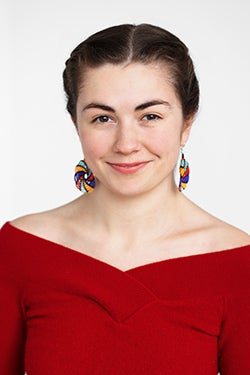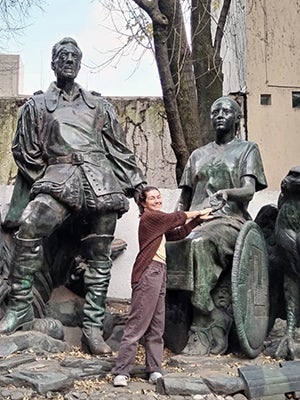Undergraduate Research
Anna Sheik '23
OUR Featured Researcher: Anna Sheik ’23

Anna Sheik (she/her) is majoring in history and Latin American studies. She conducts research under the mentorship of Professor of History and Comparative American Studies Pablo Mitchell. Her project is titled “Bridging the Gap: Malinche (Re)Imagined in Mexico and the Borderlands from 1960-1995.”
Please describe your project:
The Indigenous Mexican woman most commonly known as La Malinche is today mainly remembered for her role in the conquest of Mexico as Hernan Cortes’ translator. Yet she was also his confidante and advisor, his mistress and the mother of Mexico's first mestizo children (children of both Indigenous and Spanish heritage). Though revered by the Spanish during the colonial period for her intelligence and conversion to Christianity, she was, until recently, seen by many Mexicans as a traitor to the nation for her role in the conquest. Her legacy today is more nuanced. She is seen as a victim, the Mother of a nation, and yet she bears the burden of blame placed on Indigenous women for the conquest. My research focuses on the period of greatest change to her image (the 1960’s -1990’s) during which Mexican-American women of the Borderlands rewrote her as a feminist symbol, Mexican nationalists claimed her as a key part of Mexican identity and Mexican activists, writers and artists used her image to draw attention to neoliberalism and Indigenous issues.
A brief summary (the elevator speech) of your research project:
My research focuses on changing representations of the historical figure La Malinche, the Indigenous Mexican woman who acted as translator, advisor and mistress to Hernan Cortes during the conquest of Mexico, from 1960 to 1995 in Mexico and on the Borderlands. The turbulent histories and politics of both of these places in the latter half of the 20th century, rising social movements, and ideas of Mexican nationalism all contributed to a diverse array of images of Malinche, from feminist symbol to traitor, to victim and mother figure. Through these many and varied representations in popular culture, La Malinche has become mythologized and thus lives on into the present.
Why is your research important?
From a historical perspective, the legacy of La Malinche can tell us more about the people who shaped it than it can about the woman herself. More broadly, my research addresses the ways in which an Indigenous, female figure is remembered, which in turn affects present-day perceptions of Indigenous women in Mexico and Mexican-American women in the US.
What knowledge has your research contributed to your field?
My honors thesis combines a diverse array of sources spanning literature, art, song, puppet theater, sculpture and primary school textbooks to analyze shifting narratives of Malinche in Mexico and on the Borderlands from the 1960’s to 1990’s. I argue that Malinche’s image has become so ubiquitous in both of these regions because politicians, the Mexican government, the Chicana movement, indigenous peoples, scholars, writers, and folk artists, among others, constructed their own versions of Malinche to meet their own ends; whether to promote Mexican nationalism, protest neocolonialism, or create a heroine to embolden a movement. This fragmenting of Malinche’s story has effectively mythologized her; ingraining her in Mexican and Borderlands culture, thought and even its landscape.
What is your favorite aspect of the research process?
In January I had the opportunity to travel to Mexico City and the Library of Congress in Washington DC to gather primary sources in historical archives. The process of going to an archive in itself is very exciting; oftentimes you have to make a research appointment with an archivist beforehand and most archives issue researchers physical ID cards before you can request materials. Most of my time was spent leafing through folders and boxes of materials that included letters, maps, literature, plays, other researchers notes, photographs, interview transcriptions and videos. Both the process of tracking down sources that I could use and stumbling across sources I hadn’t expected to find felt like I was unearthing hidden gems and has been one of the most rewarding aspects of my project so far.
 How has working with your mentor impacted the development of your research project? How has it impacted you as a researcher?
How has working with your mentor impacted the development of your research project? How has it impacted you as a researcher?
Working with Professor Mitchell has been the other most rewarding aspect of my project. On a practical level, he has guided my research, kept me focused on my research questions and taught me how to write an academic thesis in the field of history. More importantly, his unwavering support and belief in me has encouraged me to believe in my own capabilities and grown my confidence as a researcher and writer.
How has the research you’ve conducted contributed to your professional or academic development?
Crafting a nearly 70 page thesis from my research has significantly improved my abilities as a writer. It has also inspired me to return to Mexico next year, not to pursue official research, but to deepen my understanding of its history and culture. I hope to teach English as a Fulbright ETA or independently.
What advice would you give to a younger student wanting to get involved in research in your field?
I would encourage younger students to build relationships with professors, even if you’re unsure which field you want to go into, professors can be instrumental in introducing students to what research in their field looks like and getting students involved in it.